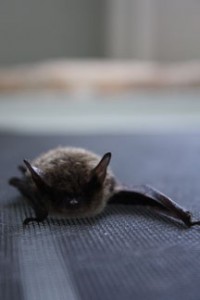Bats!
- Share
- Tweet
- Pin
- Share

Photo by Ryan Miller.
2:30 am – I am startled awake by an audible flutter near my head. As I turn on the lights I am horrified to see two small bats in a flying frenzy. I quickly grabbed my iPad and ran in the bathroom, shut the door and Googled “How to get rid of bats in a bedroom.”
When I noticed Newport State Park was offering an evening bat program over Labor Day weekend, I thought it’s time to learn about these fear-instilling creatures.
There are seven types of bats in Wisconsin. The most common is the little brown bat, which is most likely the type of bat that found its way inside my bedroom through an ever so small opening at the top of my window.
And contrary to what most people think, only a mere one-percent of bats have rabies. The benefits outweigh the drawbacks, naturalist Beth Bartoli tells the audience at Newport. These flying mammals eat 600 mosquitoes an hour and are considered the largest nighttime insect predators. In addition, bats pollinate flowers and disperse seeds. “Something else most people do not know is that bats are the only true flying mammal. Flying squirrels actually do not fly, they glide,” she tells us.
Also surprising to me, is that bats have been put on the state’s threatened list in 2011. White-nose syndrome, which scientists believe originated in Europe, has found its way to the U.S. and has spread to 23 states including Wisconsin. The name of the disease refers to the white fungal growth found on the noses of infected bats. The syndrome has already killed five million bats since 2006 and it’s not known what causes the syndrome, Bartoli says.
The reason for the bat program at Newport State Park, Bartoli explains, is to inform and educate the public about the syndrome and about the benefits of bats. As civil twilight (defined as when the sun is six degrees below the horizon) grew near, the audience followed Bartoli outside to observe how park naturalists are monitoring the bat population using an Anabat detector. A little larger than a smart phone and thicker, this digital detector uses ultrasound to record and monitor bat activity. When a bat flies within the vicinity of the Anabat detector it clicks like a Geiger counter and the bat calls can be seen, like sound waves, on the handheld screen. Different sound waves denote different species. Using this detector throughout Wisconsin’s state parks helps naturalists monitor which of the bat species may be declining.
I definitely felt more compassionate towards bats after the program. How did I get rid of the bats in my bedroom? Opened a window and shooed them out. Easy.
